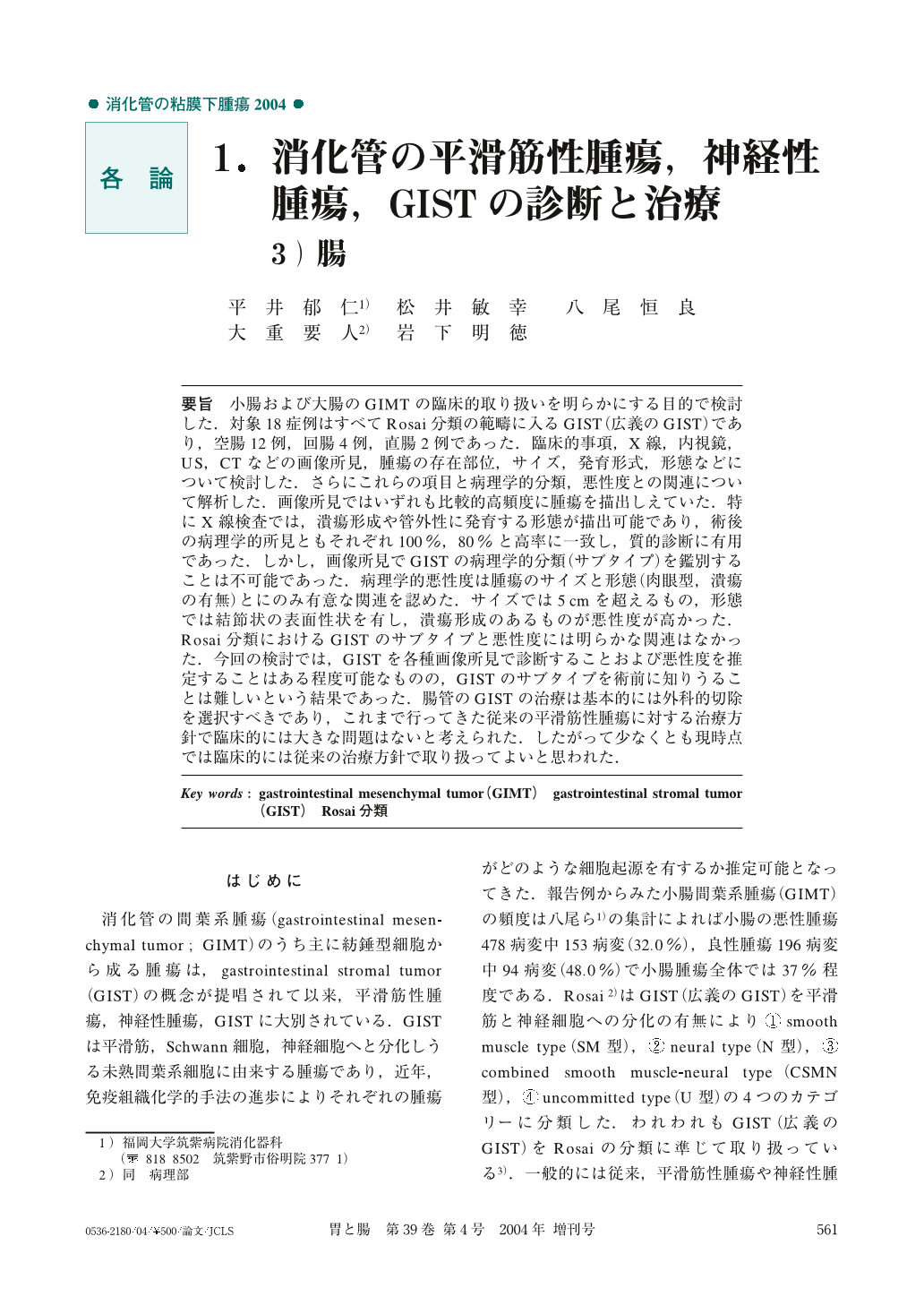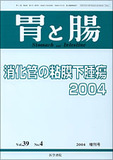Japanese
English
- 有料閲覧
- Abstract 文献概要
- 1ページ目 Look Inside
- 参考文献 Reference
- サイト内被引用 Cited by
要旨 小腸および大腸のGIMTの臨床的取り扱いを明らかにする目的で検討した.対象18症例はすべてRosai分類の範疇に入るGIST(広義のGIST)であり,空腸12例,回腸4例,直腸2例であった.臨床的事項,X線,内視鏡,US,CTなどの画像所見,腫瘍の存在部位,サイズ,発育形式,形態などについて検討した.さらにこれらの項目と病理学的分類,悪性度との関連について解析した.画像所見ではいずれも比較的高頻度に腫瘍を描出しえていた.特にX線検査では,潰瘍形成や管外性に発育する形態が描出可能であり,術後の病理学的所見ともそれぞれ100%,80%と高率に一致し,質的診断に有用であった.しかし,画像所見でGISTの病理学的分類(サブタイプ)を鑑別することは不可能であった.病理学的悪性度は腫瘍のサイズと形態(肉眼型,潰瘍の有無)とにのみ有意な関連を認めた.サイズでは5cmを超えるもの,形態では結節状の表面性状を有し,潰瘍形成のあるものが悪性度が高かった.Rosai分類におけるGISTのサブタイプと悪性度には明らかな関連はなかった.今回の検討では,GISTを各種画像所見で診断することおよび悪性度を推定することはある程度可能なものの,GISTのサブタイプを術前に知りうることは難しいという結果であった.腸管のGISTの治療は基本的には外科的切除を選択すべきであり,これまで行ってきた従来の平滑筋性腫瘍に対する治療方針で臨床的には大きな問題はないと考えられた.したがって少なくとも現時点では臨床的には従来の治療方針で取り扱ってよいと思われた.
Gastrointestinal stromal tumor (GIST) of the intestine is a rare entity and the diagnosis, clinical features and clinical treatment are not yet clear. The aim of this study is to clarify the clinical decision for patients with GIST of the intestine. Eighteen patients (4 : male, 14: female) with GIST of the intestine (12: jejunum, 4: ileum, 2: rectum) were studied. Clinical features, findings of X-ray examination, US, CT scan and angiography and pathological characteristics (site, size, growth pattern, superficial findings, subtype of GIST) were investigated. X-ray examination,US,CT scan and angiography were able, to a great extent, to reveal the existence of GIST tumors. Especially, X-ray examination can make it possible to estimate the extraluminal pattern and superficial condition (ulcer, erosion) of the tumors. Therefore, it was possible to distinguish GIST from other tumors of the intestine by using these diagnostic images.
Tumor size greater than5cm and nodular surface were associated with a high risk of malignancy. All cases were GIST in the wide sense by Rosai's classification. Using this classification, our cases of GIST were classified into3cases of neural (N) type, 8of smooth muscle (SM) type, 2of combined smooth muscle-neural (CSMN) type and5of uncommitted (U, GIST in the narrow sense) type. It was difficult to distinguish subtypes of GIST by any of the diagnostic images available to us. Neither was there any relationship between subtypes of GIST and malignant potential in this study. Until now, we have treated these tumors as conventional myogenic tumors, not as GIST subtypes, but, there was no major clinical consequence. Maybe clinical decision for subtypes of GIST should be the same as that we make for conventional myogenic tumors.
1) Department of Gastroenterology, Fukuoka University Chikushi Hospital, Chikushino, Japan

Copyright © 2004, Igaku-Shoin Ltd. All rights reserved.


